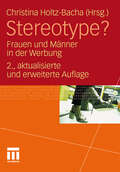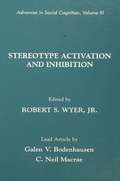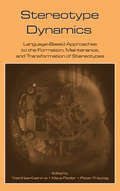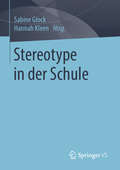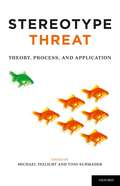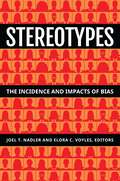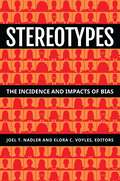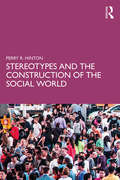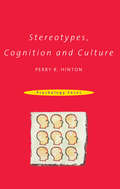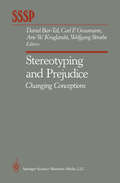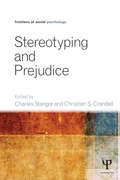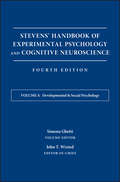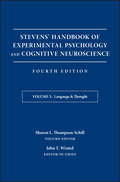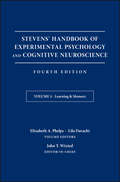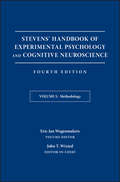- Table View
- List View
Stereotype?: Frauen und Männer in der Werbung
by Christina Holtz-BachaFrauen sind jung, schön und schlank. Männer sind harte Jungs, die Tölpel in der Küche oder sehen einfach nur gut aus. Die Klage darüber, dass die Werbung Frauen und Männer auf solche Stereotypen reduziert, ist ebenso alt wie die Befürchtungen, dass diese Stereotypen gesellschaftliche Auswirkungen haben. Gelten sie heute noch? Dieses Buch zieht Bilanz nach rund 50 Jahren Forschung zu Werbung und Geschlechterstereotypen und legt neue Ergebnisse aus der Analyse von Werbung vor sowie darüber, wie Rezipientinnen und Rezipienten mit solcher Werbung umgehen.
Stereotype Activation and Inhibition: Advances in Social Cognition, Volume XI (Advances in Social Cognition Series #Vol. 11)
by Robert S. WyerThe use of social sterotypes as a basis for judgments and behavioral decisions has been a major focus of social psychological theory and research since the field began. Although motivational and cognitive influences on stereotyping have been considered, these two general types of influence have rarely been conceptually integrated within a common theoretical framework. Nevertheless, almost every area of theoretical and empirical concern in social cognition--areas such as the interpretation of new information, memory and retrieval processes, impression formation, the use of heuristic vs. analytic processing strategies, the role of affect in information processing, and self-esteem maintenance--has implications for this important social phenomenon. This volume's target article brings together the research of Galen Bodenhausen, Neil Macrae, and others within a theoretical framework that accounts for the processes that underlie both the activation of stereotypes and attempts to suppress their influence. They consider several stages of processing, including: *the categorization of a stimulus person; *the influence of this categorization on the interpretation of information about the stimulus person; and *the social judgments and behavioral decisions that are ultimately made. The stereotype activation and suppression mechanisms that the target article authors consider operate at all of these stages. Their conceptualization provides a framework within which the interrelatedness of processing at these stages can be understood. The 11th in the series, this volume includes companion articles that help to refine and extend the target article's conceptualization and make important theoretical contributions in their own right. They are written by prominent researchers in cognitive and social psychology, many of whom are active contributors to research and theory on stereotyping. They address the following topics: * the role of power and control in stereotype-based information processing; * the influence of prejudice; * self-regulatory processes; * social categorization; * the correction processes that result from perceptions of bias; and * the conceptualization of stereotypes themselves.
Stereotype Activation and Inhibition: Advances in Social Cognition, Volume XI (Advances in Social Cognition Series)
by Robert S. WyerThe use of social sterotypes as a basis for judgments and behavioral decisions has been a major focus of social psychological theory and research since the field began. Although motivational and cognitive influences on stereotyping have been considered, these two general types of influence have rarely been conceptually integrated within a common theoretical framework. Nevertheless, almost every area of theoretical and empirical concern in social cognition--areas such as the interpretation of new information, memory and retrieval processes, impression formation, the use of heuristic vs. analytic processing strategies, the role of affect in information processing, and self-esteem maintenance--has implications for this important social phenomenon. This volume's target article brings together the research of Galen Bodenhausen, Neil Macrae, and others within a theoretical framework that accounts for the processes that underlie both the activation of stereotypes and attempts to suppress their influence. They consider several stages of processing, including: *the categorization of a stimulus person; *the influence of this categorization on the interpretation of information about the stimulus person; and *the social judgments and behavioral decisions that are ultimately made. The stereotype activation and suppression mechanisms that the target article authors consider operate at all of these stages. Their conceptualization provides a framework within which the interrelatedness of processing at these stages can be understood. The 11th in the series, this volume includes companion articles that help to refine and extend the target article's conceptualization and make important theoretical contributions in their own right. They are written by prominent researchers in cognitive and social psychology, many of whom are active contributors to research and theory on stereotyping. They address the following topics: * the role of power and control in stereotype-based information processing; * the influence of prejudice; * self-regulatory processes; * social categorization; * the correction processes that result from perceptions of bias; and * the conceptualization of stereotypes themselves.
Stereotype Dynamics: Language-Based Approaches to the Formation, Maintenance, and Transformation of Stereotypes
by Yoshihisa Kashima Klaus Fiedler Peter FreytagThis volume addresses the role of communication in stereotype dynamics, while placing the phenomenon of social stereotypes appropriately in the socio-cultural context. Stereotype Dynamics assembles top researchers in the field to investigate stereotype formation, maintenance, and transformation through interpersonal facets of communication.Section
Stereotype Dynamics: Language-Based Approaches to the Formation, Maintenance, and Transformation of Stereotypes
by Yoshihisa Kashima Klaus Fiedler Peter FreytagThis volume addresses the role of communication in stereotype dynamics, while placing the phenomenon of social stereotypes appropriately in the socio-cultural context. Stereotype Dynamics assembles top researchers in the field to investigate stereotype formation, maintenance, and transformation through interpersonal facets of communication.Section
Stereotype in der Schule
by Sabine Glock Hannah KleenDas Buch liefert neue, in Deutschland noch relativ unbekannte Forschung zum Einfluss von Stereotypen in der Schule und einen hervorragenden theoretischen und empirischen Überblick zu dem Themenkomplex. Beschrieben und analysiert werden vor allem Stereotype im Kontext unterschiedlicher Merkmale von Schüler*innen wie Geschlecht, sonderpädagogischem Förderbedarf, Migrationsverhältnisse und sozio-ökonomischem Status.
Stereotype Threat: Theory, Process, and Application
by Michael Inzlicht Toni SchmaderThe 21st century has brought with it unparalleled levels of diversity in the classroom and the workforce. It is now common to see in elementary school, high school, and university classrooms, not to mention boardrooms and factory floors, a mixture of ethnicities, races, genders, and religious affiliations. But these changes in academic and economic opportunities have not directly translated into an elimination of group disparities in academic performance, career opportunities, and levels of advancement. Standard explanations for these disparities, which are vehemently debated in the scientific community and popular press, range from the view that women and minorities are genetically endowed with inferior abilities to the view that members of these demographic groups are products of environments that frustrate the development of the skills needed for success. Although these explanations differ along a continuum of nature vs. nurture, they share in common a presumption that a large chunk of our population lacks the potential to achieve academic and career success. In contrast to intractable factors like biology or upbringing, the research summarized in this book suggests that factors in one's immediate situation play a critical yet underappreciated role in temporarily suppressing the intellectual performance of women and minorities, creating an illusion of group differences in ability. Research conducted over the course of the last fifteen years suggests the mere existence of cultural stereotypes that assert the intellectual inferiority of these groups creates a threatening intellectual environment for stigmatized individuals - a climate where anything they say or do is interpreted through the lens of low expectations. This stereotype threat can ultimately interfere with intellectual functioning and academic engagement, setting the stage for later differences in educational attainment, career choice, and job advancement.
Stereotype Threat im Englischunterricht: Zu den Bildungschancen von Jugendlichen mit Migrationshintergrund
by Christian HelmchenIn diesem Buch untersucht Christian Helmchen, ob sich Stereotype Threat – konzeptualisiert durch Stigma Consciousness, Ingroup Identification und Domain Identification – negativ auf Schulleistungen der Fächer Mathematik, Deutsch und Englisch auswirkt. Die Domäne Englisch steht aufgrund der besonderen Bedeutung von Sprache für die Identität von Schülern mit Migrationshintergrund und der mit ihrer Mehrsprachigkeit einhergehenden besonderen sprachlichen Kompetenz im Fokus der Untersuchung. Die Ergebnisse zeigen, dass Stereotype Threat einen negativen Einfluss auf Schulleistung hat, vor allem in der Domäne Englisch. Zugleich wird deutlich, dass die Prädiktoren auch aufeinander wirken und Effekte auf Leistung mediiert werden.
Stereotypes: The Incidence and Impacts of Bias
by Joel T. Nadler and Elora C. VoylesProvides an invaluable primer on how culturally accepted stereotypes are impacting people throughout the United States.Stereotypes—both intentional and unconscious—and the harms they cause are increasingly featuring in the news. Here a team of top researchers examines current and emerging research on how stereotypes begin, grow, and harm the members of society—and what can be done to stop them. The authors explain what actions lead to the development and manifestation of stereotypes against groups ranging from racial, ethnic, sexual, and religious minorities to men, women, immigrants, the disabled, and more. They detail the newest studies to help us understand the psychological and social processes that spur and sustain stereotypes, how those affect behavior and decision-making, and how the targeted groups are affected by micro-aggressions and nonverbal behaviors. This volume will interest students of psychology, counseling, social work, law enforcement and legal studies, race and ethnicity, LGBTQ studies, gender studies, public policy, and politics.
Stereotypes: The Incidence and Impacts of Bias
by Joel T. Nadler Elora C. VoylesProvides an invaluable primer on how culturally accepted stereotypes are impacting people throughout the United States.Stereotypes—both intentional and unconscious—and the harms they cause are increasingly featuring in the news. Here a team of top researchers examines current and emerging research on how stereotypes begin, grow, and harm the members of society—and what can be done to stop them. The authors explain what actions lead to the development and manifestation of stereotypes against groups ranging from racial, ethnic, sexual, and religious minorities to men, women, immigrants, the disabled, and more. They detail the newest studies to help us understand the psychological and social processes that spur and sustain stereotypes, how those affect behavior and decision-making, and how the targeted groups are affected by micro-aggressions and nonverbal behaviors. This volume will interest students of psychology, counseling, social work, law enforcement and legal studies, race and ethnicity, LGBTQ studies, gender studies, public policy, and politics.
Stereotypes and the Construction of the Social World
by Perry R. HintonStereotypes and the Construction of the Social World explores the complexity of stereotypes, guiding the reader through issues of definition and theoretical explanations from psychology and other disciplines. The book examines why people use stereotypes, which have often been represented as inaccurate, rigid and discriminatory. If that is what they are, then why would people employ such ‘faulty’ or ‘biased’ views of others? Whilst this book presents a detailed and comprehensive analysis of the psychological research into the individual use of stereotypes, it also presents this research within its ideological and historical context, revealing the important sociocultural factors in what we mean by ‘stereotypes’. From the politics of representation and inter-group power relations, alongside individual social cognitive issues, the book provides a comprehensive and cross-disciplinary account of stereotypes and stereotyping. Featuring a wealth of real-world examples, it will be essential reading for all students and researchers of stereotypes.
Stereotypes and the Construction of the Social World
by Perry R. HintonStereotypes and the Construction of the Social World explores the complexity of stereotypes, guiding the reader through issues of definition and theoretical explanations from psychology and other disciplines. The book examines why people use stereotypes, which have often been represented as inaccurate, rigid and discriminatory. If that is what they are, then why would people employ such ‘faulty’ or ‘biased’ views of others? Whilst this book presents a detailed and comprehensive analysis of the psychological research into the individual use of stereotypes, it also presents this research within its ideological and historical context, revealing the important sociocultural factors in what we mean by ‘stereotypes’. From the politics of representation and inter-group power relations, alongside individual social cognitive issues, the book provides a comprehensive and cross-disciplinary account of stereotypes and stereotyping. Featuring a wealth of real-world examples, it will be essential reading for all students and researchers of stereotypes.
Stereotypes, Cognition and Culture
by Dr Perry HintonWhat are stereotypes and why do we use them? Are all stereotypes bad? Can we stop people from using them? Questions such as these have fascinated social psychologists for many years.Perry Hinton provides an accessible introduction to this key area, giving a critical and concise overview of the influential theories and approaches, as well as insights into recent work on the role of language and culture in stereotyping.
Stereotypes, Cognition and Culture
by Dr Perry HintonWhat are stereotypes and why do we use them? Are all stereotypes bad? Can we stop people from using them? Questions such as these have fascinated social psychologists for many years.Perry Hinton provides an accessible introduction to this key area, giving a critical and concise overview of the influential theories and approaches, as well as insights into recent work on the role of language and culture in stereotyping.
Stereotyping and Prejudice: Changing Conceptions (Springer Series in Social Psychology)
by Daniel Bar-TalThe study of stereotyping and prejudice is a study of human nature, group mem bership, and intergroup relationships. It sheds light on each of these aspects of social psychology. With respect to the first two, it has been observed that since groups provide the best framework for satisfying various human needs, individuals continuously organize themselves in collectives. They belong to a variety of groups-many of which they voluntarily select and some to which they are ascribed. Group membership, therefore, is one of the most salient and important of an indi vidual's characteristics. The implication of this characteristic is that human beings not only constantly classify other people into group categories, either by identifying membership or constructing their own categories, but also judge and evaluate them on this basis. The stereotypes and prejudice are outcomes of this process. They are the beliefs and attitudes toward members of another group. In addition, the study of stereotyping and prejudice reflects an interest in inter group relationships. While we recognize that a discussion of intergroup relation ships may focus on behaviors describing actions such as confrontations, violence, wars, cooperation, alliance, negotiation, or coordination, we also believe that each of these intergroup behaviors is mediated by perceptions, beliefs, and attitudes. In the case of intergroup behaviors, the listed actions are not performed instinctively or mindlessly, but are preceded by cognitive processes which, among other outputs, involve the formation of stereotypes and prejudice toward the other group.
Stereotyping and Prejudice: Key Readings (Frontiers of Social Psychology)
by Charles Stangor Christian S. CrandallThis volume presents a contemporary and comprehensive overview of the great diversity of theoretical interests, new ideas, and practical applications that characterize social psychological approaches to stereotyping and prejudice. All the contributions are written by renowned scholars in the field, with some chapters focusing on fundamental principles, including research questions about the brain structures that help us categorize and judge others, the role of evolution in prejudice, and how prejudice relates to language, communication, and social norms. Several chapters review a new dimension that has frequently been understudied—the role of the social context in creating stereotypes and prejudice. Another set of chapters focuses on applications, particularly how stereotypes and prejudice really matter in everyday life. These chapters include studies of their impact on academic performance, their role in small group processes, and their influence on everyday social interactions. The volume provides an essential resource for students, instructors, and researchers in social and personality psychology, and is also an invaluable reference for academics and professionals in related fields who have an interest in the origins and effects of stereotyping and prejudice.
Stereotyping and Prejudice (Frontiers of Social Psychology)
by Charles Stangor Christian S. CrandallThis volume presents a contemporary and comprehensive overview of the great diversity of theoretical interests, new ideas, and practical applications that characterize social psychological approaches to stereotyping and prejudice. All the contributions are written by renowned scholars in the field, with some chapters focusing on fundamental principles, including research questions about the brain structures that help us categorize and judge others, the role of evolution in prejudice, and how prejudice relates to language, communication, and social norms. Several chapters review a new dimension that has frequently been understudied—the role of the social context in creating stereotypes and prejudice. Another set of chapters focuses on applications, particularly how stereotypes and prejudice really matter in everyday life. These chapters include studies of their impact on academic performance, their role in small group processes, and their influence on everyday social interactions. The volume provides an essential resource for students, instructors, and researchers in social and personality psychology, and is also an invaluable reference for academics and professionals in related fields who have an interest in the origins and effects of stereotyping and prejudice.
Stevens' Handbook of Experimental Psychology and Cognitive Neuroscience, Developmental and Social Psychology: Learning And Memory
by John T. Wixted Simona GhettiIV. Developmental & Social Psychology: Simona Ghetti (Volume Editor) (Topics covered include development of visual attention; self-evaluation; moral development; emotion-cognition interactions; person perception; memory; implicit social cognition; motivation group processes; development of scientific thinking; language acquisition; development of mathematical reasoning; emotion regulation; emotional development; development of theory of mind; category and conceptual development; attitudes; executive function.)
Stevens' Handbook of Experimental Psychology and Cognitive Neuroscience, Developmental and Social Psychology
by John T. Wixted Simona GhettiIV. Developmental & Social Psychology: Simona Ghetti (Volume Editor) (Topics covered include development of visual attention; self-evaluation; moral development; emotion-cognition interactions; person perception; memory; implicit social cognition; motivation group processes; development of scientific thinking; language acquisition; development of mathematical reasoning; emotion regulation; emotional development; development of theory of mind; category and conceptual development; attitudes; executive function.)
Stevens' Handbook of Experimental Psychology and Cognitive Neuroscience, Language and Thought: Developmental And Social Psychology
by John T. Wixted Sharon L. Thompson-SchillIII. Language & Thought: Sharon Thompson-Schill (Volume Editor) (Topics covered include embodied cognition; discourse and dialogue; reading; creativity; speech production; concepts and categorization; culture and cognition; reasoning; sentence processing; bilingualism; speech perception; spatial cognition; word processing; semantic memory; moral reasoning.)
Stevens' Handbook of Experimental Psychology and Cognitive Neuroscience, Language and Thought: Developmental And Social Psychology
by John T. Wixted Sharon L. Thompson-SchillIII. Language & Thought: Sharon Thompson-Schill (Volume Editor) (Topics covered include embodied cognition; discourse and dialogue; reading; creativity; speech production; concepts and categorization; culture and cognition; reasoning; sentence processing; bilingualism; speech perception; spatial cognition; word processing; semantic memory; moral reasoning.)
Stevens' Handbook of Experimental Psychology and Cognitive Neuroscience, Learning and Memory: Learning And Memory
by John T. Wixted Elizabeth A. Phelps Lila DavachiI. Learning & Memory: Elizabeth Phelps & Lila Davachi (Volume Editors)Topics covered include working memory; fear learning; education and memory; memory and future imagining; sleep and memory; emotion and memory; motivation and memory; inhibition in memory; attention and memory; aging and memory; autobiographical memory; eyewitness memory; and category learning.
Stevens' Handbook of Experimental Psychology and Cognitive Neuroscience, Learning and Memory
by John T. Wixted Elizabeth A. Phelps Lila DavachiI. Learning & Memory: Elizabeth Phelps & Lila Davachi (Volume Editors)Topics covered include working memory; fear learning; education and memory; memory and future imagining; sleep and memory; emotion and memory; motivation and memory; inhibition in memory; attention and memory; aging and memory; autobiographical memory; eyewitness memory; and category learning.
Stevens' Handbook of Experimental Psychology and Cognitive Neuroscience, Methodology
by John T. Wixted Eric-Jan WagenmakersV. Methodology: E. J. Wagenmakers (Volume Editor) Topics covered include methods and models in categorization; cultural consensus theory; network models for clinical psychology; response time modeling; analyzing neural time series data; models and methods for reinforcement learning; convergent methods of memory research; theories for discriminating signal from noise; bayesian cognitive modeling; mathematical modeling in cognition and cognitive neuroscience; the stop-signal paradigm; hypothesis testing and statistical inference; model comparison in psychology; fmri; neural recordings; open science; neural networks and neurocomputational modeling; serial versus parallel processing; methods in psychophysics.
Stevens' Handbook of Experimental Psychology and Cognitive Neuroscience, Methodology
by John T. Wixted Eric-Jan WagenmakersV. Methodology: E. J. Wagenmakers (Volume Editor) Topics covered include methods and models in categorization; cultural consensus theory; network models for clinical psychology; response time modeling; analyzing neural time series data; models and methods for reinforcement learning; convergent methods of memory research; theories for discriminating signal from noise; bayesian cognitive modeling; mathematical modeling in cognition and cognitive neuroscience; the stop-signal paradigm; hypothesis testing and statistical inference; model comparison in psychology; fmri; neural recordings; open science; neural networks and neurocomputational modeling; serial versus parallel processing; methods in psychophysics.
